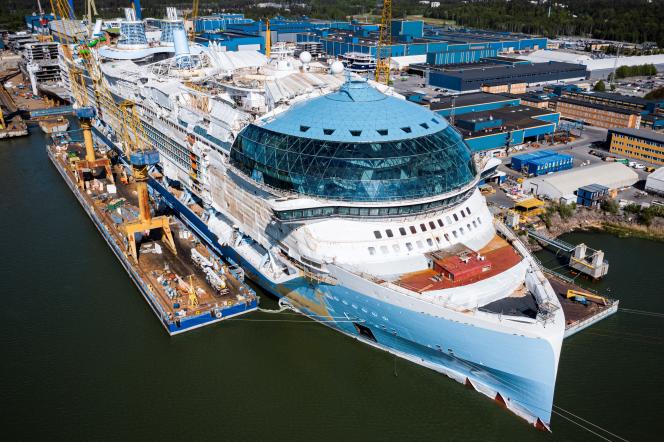Walkie-talkie in hand, she looks concentrated. On this late June morning, Sylvie (she doesn’t want to give her name) is on the lookout. From the terminal of the port of Zeebrugge, in Belgium, where she officiates, the person in charge of the security of the places supervises from afar the liner which has just docked. “For us, the challenge remains to deal with these thousands of passengers arriving in a short time”concedes this official. “There are always people who get lost or who miss the departure of the ship. »
A short distance away, theAida Prima is at the quay – imposing, 300 meters long, with its cabins lined up on eighteen floors. Barely arrived from Le Havre, this ship from the Carnival group (world number one in the sector, ahead of Royal Caribbean and MSC) will only stop here for ten hours, before resuming its journey to Hamburg (northern Germany). On board, a line of passengers is already moving impatiently towards the bridge to disembark. Families, couples – mostly Germans – while outside an armada of buses awaits them. Direction Bruges, the “Venice of the North”, about fifteen kilometers away.
In 2019, before the Covid-19 pandemic, the port of Zeebrugge hosted around 140 cruise ships. To date, 185 have landed there; in 2024, it will be nearly 200. Here as elsewhere, their incessant ballet has resumed with renewed vigor. If, in 2022, 20 million passengers returned to this type of leisure, in 2023, they should be 31.5 million, a level higher than the period preceding the health crisis, according to the International Association of Cruise Lines (CLIA). ), which brings together 93% of the companies on a world fleet of 350 ships. “We attract a younger audience [d’un âge moyen de 45 ans]Gen X customers [née entre 1960 et 1980]millennials [nés entre 1980 et 2000], because the offer is diversifying. On board, leisure activities are also more sporty », underlines Marie-Caroline Laurent, president of the CLIA, to justify this attraction.
In order to anticipate demand, ship order books are flourishing. In total, no less than 67 are under construction worldwide (62 in Europe and 5 in Asia), over the period from 2023 to 2028. The Saint-Nazaire shipyards alone are building 10. In June, they delivered the MSC Euribia and should put the Celebrity-Ascent on the market this fall.
excess
Of these ships, about 40% have a capacity of 1,000 to 3,000 people, and 25% go beyond that. The race for gigantism, defended in the name of economies of scale, has a bright future ahead of it. Proof of this, in January 2024 will leave the Finnish shipyards in Turku l‘Icon-of-the-Seasof the Royal Caribbean, the largest ship in the world, five times the size of the titanic and which will be able to transport 10,000 people, including 7,600 passengers. On board, a wealth of attractions: seven swimming pools, fifteen bars, a surf simulator, a glacier and a water park, or even a gigantic glass dome that will cover the bow.
You have 60.17% of this article left to read. The following is for subscribers only.
